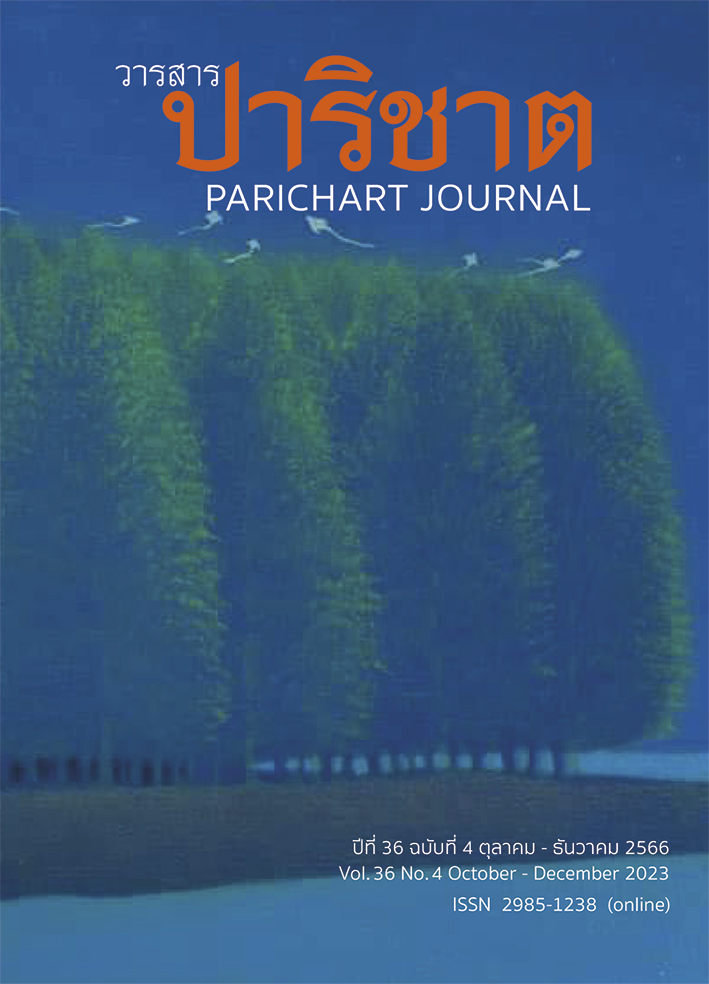The Application of Livelihood Assets for Tourism Development: A Case of Phu Thap Boek Area, Lom Kao District, Phetchabun Province
Main Article Content
Abstract
The main objective of this paper was to explain how households and community applied their livelihood assets to develop tourism in Phu Thap Boek Area, Lomkao District, Phetchabun Province. The conceptual framework was based on the livelihood assets. With the qualitative research methodology, the purposive sampling technique was utilized to collect data from the informants; they were classified into 4 groups consisting of government agencies or local administrations, community leaders, business groups or organizations, and households. The study tools included both the structured questionnaire and the observation form. The study result revealed that the tourism development in Phu Thap Boek area was based on the livelihood assets of 2 levels: the household level and the community level. 1) At the household level, the agricultural households there needed an extra job with additional income. Thus, their possessing livelihood assets consisting of human capital (education, knowledge, skill, competency) and physical capital (vegetable and fruit plots, household labors) were converted into tourist residences and attractions, whereas the financial capital (current assets, cash and loan) and social capital (kinship system) were used to set the strategy and develop the tourism business. 2) At the community level, the collaboration of community members has formed the process and the organization to drive the tourism related activities in the community. In short, the tourism development in Phu Thap Boek was based on the following key capitals, the natural capital (picturesque landscape and all-year-round cool weather), the physical capital (road and public utility – electricity, water), the social capital (kinship, groups and organizations), the human capital (education of local people, community labor), and the financial capital (budget from the government).
Article Details

This work is licensed under a Creative Commons Attribution-NonCommercial-NoDerivatives 4.0 International License.
References
National Strategy 2018 – 2037. (2018). In The Royal Thai Government Gazette Vol. 135 No. 82 (p 1-61). https://www.nesdc.go.th/download/document/SAC/NS_PlanOct2018.pdf. (in Thai)
World Tourism Organization. (2018). UNWTO Tourism Highlights, 2018 Edition. https://doi.org/10.18111/9789284419876
Pampasit, R. (2022). Community-based Tourism and Community Economic Development: The Case of Lower Northern Region, Thailand. Journal of Community Development Research (Humanities and Social Sciences), 15(4), 110-124.
Noonpugdee, T., & Nganwai, N. (2021). The COVID-19 Crisis: ASEAN Security. National Defence Studies Institute Journal. 12(3), 15 – 28. thaijo.org/index.php/ndsijournal/article/view/255292/173808 (in Thai)
Department for International Development: DFID. (1999). Sustainable Livelihoods Guide Sheets.
Narongchai, W., & Chumnanmak, R. (2019). Livelihood Capital of Urban Farmer Households in Kranuan District, Khon Kaen Province. Journal of Liberal Arts Prince of Songkla University. 11(1), 179 – 203. https://so03.tci-thaijo.org/index.php/journal-la/article/view/199915/140138. (in Thai)
Chetea, M. (2014). Adapting for the Sustainable Livelihoods of Community in Budo-Su-Ngai Padi National Park: A Case Study of Community in Palukasamah Sub District, Bajoh District, Naratiwat (Master of Public Administration). Prince of Songkla University, Faculty of Management Sciences, Department of Public Administration. (in Thai)
Pampasit, R. (2019). Final Report on the Study of Tourist Behaviors and Economic/Social Benefits for Tourism – Related Communities: Case Study Lower North. (in Thai)
Pampasit, R. (2020). Final Report on the Study of Effects of Tourism on Quality of Life of
Community in Phu Thap Boek, Phetchabun Province. (in Thai).
Punyarvuttrakul, W., Madhyamapurush, W., & Amtong, N. (2018). Development and Guidelines for Highland Sustainable Tourism Management: Phu Lom Lo Case Study and Network Area. (in Thai)
Jehmamah, N., & Saisuntorn, J. (2021). Legal Measures for Control the Homestay for Sustainable Tourism. Rajapark Journal, 15(40), 160 – 172. https://so05.tci-thaijo.org/index.php/RJPJ/article/view/249285/170309. (in Thai)
Kaewkanta, S., & Poonphiphat, P. (2020). Social Capital and Community Tourism in Phu Thap Boek, Phetchabun Province. (Bachelor of Social Development). Naresuan University, Faculty of Social Sciences, Department of Sociology and Anthropology. (in Thai)
Chamber, R., & Conway, G. (1992). Sustainable Rural Livelihoods: Practical Concepts for the 21st Century. Institute of Development Studies Discussion Paper, 296, Cambridge.


